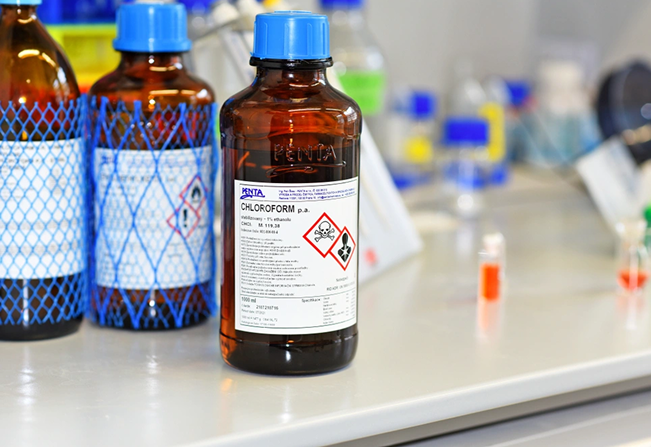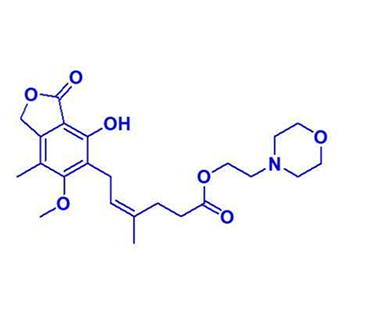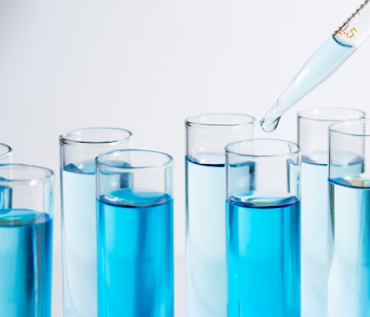Nuclear magnetic resonance (NMR) spectroscopy is an important analytical technique to elucidate the molecular structure of the compounds. Its unique physical and chemical properties make it an ideal solvent when performing this technique.
In this blog, we delve into the properties of deuterated chloroform, its role in NMR analyses, and the safety guidelines. Have fun learning about it!
What is Deuterated Chloroform?
Deuterated Chloroform, a derivative of chloroform (CHCl₃), has the hydrogen atom replaced with Deuterium, an isotope of Hydrogen. Unlike Hydrogen that has only one proton, Deuterium is made up of one proton and one neutron, making it twice as heavy as Hydrogen. Due to the presence of Deuterium in the structure, it does not produce a signal in the proton (¹H) NMR spectrum.
Properties of Deuterated Chloroform
Deuterated chloroform (CDCl₃), with a molecular weight of 120.38 g/mol has the following physical and chemical properties:
Appearance: Clear, colourless liquid
Odour: Sweet, ether-like odour
Boiling point: ~ 61.2°C
Melting Point: ~ -64°C
Solubility: Slightly water soluble, highly soluble in organic solvents
Hygroscopic Nature: Relatively stable but may slowly decompose when exposed to light and moisture, generating HCI and COCl₂ in trace amounts. This can affect NMR accuracy.
Role of Deuterated Chloroform in NMR Analyses
The unique physical and chemical properties of Deuterated Chloroform make it an ideal choice for NMR spectroscopy. Here are the following ways in which CDCl₃ enhances spectral clarity and reliability.
Minimum interference in Proton NMR: Since CDCl₃ has more than 99.8% deuteration level, meaning nearly all the hydrogen atoms are replaced with its isotope, it reduces the background noise and ensures that only the peaks from the sample are observed. In the presence of CDCl₃ contamination in trace amounts, you can observe a small and sharp peak at 7.26ppm, serving as a convenient internal reference for chemical shift calibrations.
Chemically Inert: This chemical does not react with most organic compounds; thus, it will not react with the sample and alter the results. Its chemically inert nature preserves the integrity of sensitive molecules like pharmaceuticals, natural products, and organometallic complexes.
Solubility: Deuterated Chloroform is almost a non-polar solvent; therefore, it can dissolve many organic compounds, including hydrocarbons, aromatic compounds, and polar organics with moderate polarity. This broad range of solubility allows you to simplify the workflows as you do not need to switch solvents to analyse different samples.
Physical Properties: Its low boiling point allows it to evaporate quickly after the analysis, making it easy to recover the sample soon. Its higher density than water makes separating phases in biphasic mixtures easy during sample extraction. This solvent is highly volatile, so that no residues will be left after the analyses.
Field Frequency Locking: While using deuterated chloroform, it is possible to perform field frequency locking to ensure the consistency of the magnetic field’s strength throughout the experiment. It produces stable and sharper peaks, improving the spectral resolution.
Minimum Interference of water molecule: The deuterated chloroform is slightly soluble in water; therefore, minimum water peaks are observed in the spectrum. If any moisture is absorbed, it produces a peak at 1.53 ppm, easily distinguishable from the majority of the organic compounds.
Non-Polar Nature: This solvent’s non-polar nature reduces interactions with the functional groups, which are generally polar in nature, in the sample. Thus preventing peak broadening while improving the resolution.
Quality of CDCl₃ used in NMR analyses
The quality of CDCl₃ used in the NMR spectroscopy is critical to getting accurate and reliable results. Here are the desired traits to look for in the CDCl₃:
Deuteration Level: A highly pure CDCl₃ solvent has a more than 99.8% deuteration level.
Residual CHCl₃: A highly pure CDCl₃ solvent also contains trace levels of residual CHCl₃, producing a small peak at 7.26 ppm.
Moisture content: CDCl₃ is hygroscopic. However, the ultra-pure solvent has a minimum amount of water content.
Stabilization: Over a period, CDCl₃ can decompose to form HCl. It is stabilized with small amounts of silver foil or potassium carbonate to prevent its decomposition.
Safety Guidelines
Work under a Fume Hood:
CDCl₃ is a highly volatile solvent. Its toxic vapours can cause respiratory irritation and, when inhaled in large amounts, can cause dizziness, drowsiness, or nausea. Therefore, it must be handled in a well-ventilated lab space or under the fume hood to prevent inhalation.
In case of inhalation of CDCl₃, move the person to the fresh air immediately and seek medical help if discomfort persists.Wear Gloves, Safety Goggles and Lab Coat:
CDCl₃ is a mild irritant, and exposure for a prolonged period can cause dryness, redness or dermatitis. Make use of nitrile or neoprene gloves to protect the skin. Safeguard your eyes from accidental splashes using a safety goggle. A Lab Coat acts as a barrier, protecting your skin from direct exposure.
In case of contact, make sure to rinse the affected area with ample amounts of water for at least 15 minutes.Storage:
Store it in a tightly sealed, amber-coloured bottle in a cool, well-ventilated place away from direct sunlight to prevent its degradation.Handling CDCl₃:
Dry syringes and NMR tubes should be used to prevent moisture absorption and contamination.Waste Disposal:
As CDCl₃ is toxic to the environment, do not pour it down the drain. Instead, collect the waste in a designated organic solvent container and follow the guidelines for disposing of hazardous waste.
Where to Buy Deuterated chloroform for NMR analysis?
Deuterated Chloroform is a precious solvent in NMR spectroscopy. At Advent, we provide highly pure CDCl₃ to help scientists worldwide push the boundaries of molecular exploration.
We offer more than 3500 products, including a wide range of Fine and Specialty chemicals encompassing hosts of inorganic salts, HPLC grade solids and solvents, Pharmacopeia Grade Solvents, GC grade solvents, Gas Chromatography standards. Besides, we also provide a variety of building blocks, advanced intermediates, pharma impurities and working standards.
We manufacture Pharmacopoeia Grade solvents per the cGMP and comply as per IP, BP, USP, JP, and Ph. Eur specifications.




